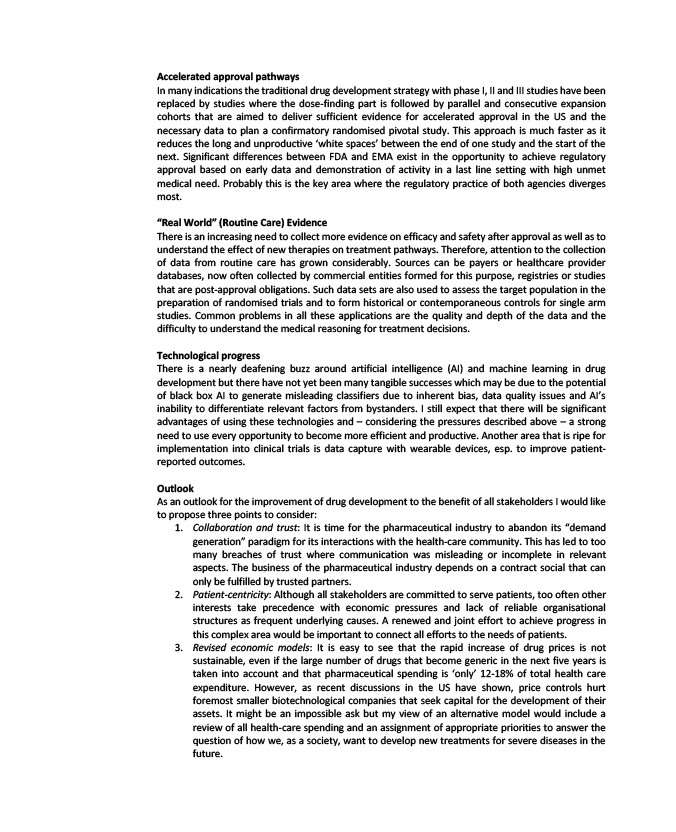
Accelerated approval pathways
In many indications the traditional drug development strategy with phase I, II and III studies have been
replaced by studies where the dose-finding part is followed by parallel and consecutive expansion
cohorts that are aimed to deliver sufficient evidence for accelerated approval in the US and the
necessary data to plan a confirmatory randomised pivotal study. This approach is much faster as it
reduces the long and unproductive ‘white spaces’ between the end of one study and the start of the
next. Significant differences between FDA and EMA exist in the opportunity to achieve regulatory
approval based on early data and demonstration of activity in a last line setting with high unmet
medical need. Probably this is the key area where the regulatory practice of both agencies diverges
most.
“Real World” (Routine Care) Evidence
There is an increasing need to collect more evidence on efficacy and safety after approval as well as to
understand the effect of new therapies on treatment pathways. Therefore, attention to the collection
of data from routine care has grown considerably. Sources can be payers or healthcare provider
databases, now often collected by commercial entities formed for this purpose, registries or studies
that are post-approval obligations. Such data sets are also used to assess the target population in the
preparation of randomised trials and to form historical or contemporaneous controls for single arm
studies. Common problems in all these applications are the quality and depth of the data and the
difficulty to understand the medical reasoning for treatment decisions.
Technological progress
There is a nearly deafening buzz around artificial intelligence (AI) and machine learning in drug
development but there have not yet been many tangible successes which may be due to the potential
of black box AI to generate misleading classifiers due to inherent bias, data quality issues and AI’s
inability to differentiate relevant factors from bystanders. I still expect that there will be significant
advantages of using these technologies and – considering the pressures described above – a strong
need to use every opportunity to become more efficient and productive. Another area that is ripe for
implementation into clinical trials is data capture with wearable devices, esp. to improve patient-reported
outcomes.
Outlook
As an outlook for the improvement of drug development to the benefit of all stakeholders I would like
to propose three points to consider:
1. Collaboration and trust: It is time for the pharmaceutical industry to abandon its “demand
generation” paradigm for its interactions with the health-care community. This has led to too
many breaches of trust where communication was misleading or incomplete in relevant
aspects. The business of the pharmaceutical industry depends on a contract social that can
only be fulfilled by trusted partners.
2. Patient-centricity: Although all stakeholders are committed to serve patients, too often other
interests take precedence with economic pressures and lack of reliable organisational
structures as frequent underlying causes. A renewed and joint effort to achieve progress in
this complex area would be important to connect all efforts to the needs of patients.
3. Revised economic models: It is easy to see that the rapid increase of drug prices is not
sustainable, even if the large number of drugs that become generic in the next five years is
taken into account and that pharmaceutical spending is ‘only’ 12-18% of total health care
expenditure. However, as recent discussions in the US have shown, price controls hurt
foremost smaller biotechnological companies that seek capital for the development of their
assets. It might be an impossible ask but my view of an alternative model would include a
review of all health-care spending and an assignment of appropriate priorities to answer the
question of how we, as a society, want to develop new treatments for severe diseases in the
future.